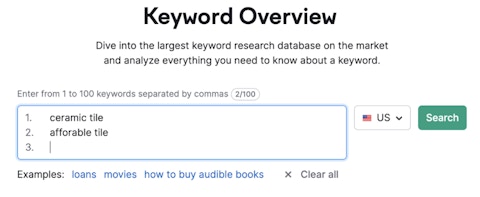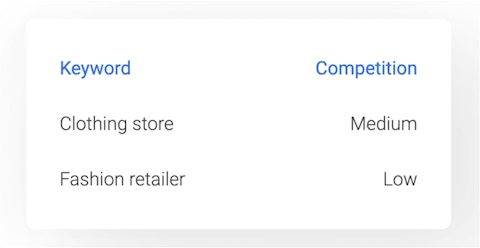Unless you are brand new to marketing, you’ve probably heard the term SEO keywords thrown around. But what are they, why do you need to care about them and how do you use them successfully?
This article covers all of these questions and more. Let’s get started.
What Are Keywords?
You may know that you need an SEO (Search Engine Optimization) strategy for your website. What you may not know is one of the essential building blocks of that strategy is keywords.
Keywords are specific words or phrases that your target audience is searching the internet for. When they search for that word or phrase, you want your website to be the first link in the search results. Using the right keywords on a webpage or in a blog is how you show up in the search results.
A keyword can be a single word or acronym (i.e. SEO), or it can be two or more words put together in a common phrase. This is often called a long-tail keyword.
For example, say you are a ceramic tile company whose primary audience is DIYers. Your first goal should be to create helpful content based on your audience’s interests. Then, you should optimize that content according to best SEO practices, such as using keywords they would use in a search. For example, they might search “affordable tile," “quality tile” or “marble style ceramic tile. (We’ll talk more about picking the right keywords a little farther down in this article.)
However, don’t confuse keywords and search queries. They’re often used interchangeably, but they are two different things.
A search query is the word or condensed phrase your audience is actually typing into the search bar (or asking Siri or ChatGPT about). Think “what is ceramic tile,” “how do I install ceramic tile myself,” “what’s the best color combination of ceramic tile,” etc. A keyword is the one or two words that all of those searches have in common — in this case, “ceramic tile.” A keyword isn’t the full search term your audience is searching for. It’s the exact word or phrase you want your website to rank in search engines for, no matter what words are before or after it.
What Are the Benefits of Keywords?
So why should you even care about using keywords? The simple answer is that they bring your website (and therefore your company) quite a few benefits.
Keywords increase organic traffic. By knowing what keywords your audience uses when searching for your product you can optimize and relate your content to how they’re searching, which will increase the visibility (rankings of your website) and increase the organic traffic.
Keywords make you look more trustworthy in visitors’ eyes. When searchers click on your search result and your page gives information based on their search words, it instantly increases trust with them. And trust is crucial if you’re going to convert them into customers.
Keywords bring in the right audience for you. High traffic numbers don’t mean anything if it’s not quality traffic. By using the right keywords, you can attract quality visitors with a higher possibility of conversion, and therefore, increased ROI.
Researching keywords provides content ideas. Researching what keywords your audience is searching tells you what their interests are and if you have that content or need to make it — and sometimes, what format to make it in. For example, “how to install tile” is a good indicator you should create a video showing tile installation steps. (If you want to really wow your visitors, give them the information in both written and video formats so they can choose which is better for them.)
How Do I Pick the Right Keywords?
When it comes to SEO, you’re not trying to rank for just any keyword in your industry. Ranking for relevant, quality keywords results in the right kinds of eyes on your website. These eyes lead to improved brand awareness and an increase in traffic.
Thankfully, researching and finding the most relevant keywords your audience uses to search for your products and services is easier than you may think.
Keyword Generation
Start with keyword generation, which is essentially compiling a list of keyword ideas based on how people search. There are a few tools you can use for this:
Google Autocomplete
Google Related Searches
Google Trends
Google Search Console
Answer the Public website
Ubersuggest website
Power Thesaurus
Google Autocomplete

For a free and easy way to get keyword ideas, Google Autocomplete is a great place to start. Enter a word or phrase into the Google search bar, and see what other suggestions pop up as you type. You’ll usually get around 10 unless it’s a very niche term.

Google related searches show at the bottom of the search results page. Showing six to eight options, these are searches that other people have Googled that are similar to the entered search term(s).
Google Trends

Google Trends is a Google adjacent site. This site shows you what people all across the world are searching for. Enter a keyword and see how it’s trending broken down by interest over time, interest by subregion, related topics and related queries.
Google Search Console

Google Search Console is a powerful tool that can be used for generating keywords and a whole lot more. But for keyword generation purposes, search console should be used to see what searches are already bringing traffic to your website.
Answer the Public

Answer the Public is a great tool to find out what people are searching for around a specific topic. Enter a keyword or phrase, and it’ll tell you what other phrases and questions are being searched for that include your keyword or phrase, along with the search volume, search difficulty, cost per click and paid difficulty.
Ubersuggest

Ubersuggest is another free keyword research tool. Enter your search term, and it will not only give you an overview of the search statistics for that word, but it will also give you other keyword ideas related to it and content ideas for that specific term.
Power Thesaurus

Not sure what words relate to your ideal word? Don’t underestimate an old-fashioned thesaurus — our favorite is Power Thesaurus. Enter your word or phrase, press enter and get a list of synonyms. And if you click on the down carrot next to a word, you get even more options. It’s a great way to expand your options list.
Know Your Audience
The next step in choosing the right SEO keywords is to know your target audience. Are they interior designers, builders, contractors, homeowners or distributors? What are they looking for that you can provide them with? Start with larger concepts first (tile) and then drill down from there (affordable tile, quality tile, marble tile, installing tile).
Note: Of course, most companies have more than one target audience. When researching keywords, focus on one audience at a time. Don’t overwhelm yourself by trying to target too many people at once.
Low-hanging keywords are:
- Keywords for which you rank on the 10+ position with some not relevant content and for which you have the opportunity to create new or optimize existing content.
- Keywords that have low competition (meaning there aren't a lot of relevant results/content for those).
- Usually long tail keywords with a significantly smaller number of searches, but are still very relevant for your site and much easier to rank for on top positions.
For example, “blue subway tile” or “elegant marble floor tile.”
One of the best ways to find low-hanging fruit keywords is using Google Search Console. It will show you what search terms Google thinks is relevant for your website, based on who is visiting it via Google searching. You can use this information to improve existing content or create new content around those keywords (only if you think those search terms are relevant based on the rest of your research, of course).
If you want to really hit the right keywords though, don’t rely on what you think people are searching for. Instead, ask them directly. Interview past customers and people from your target audience. You may find they think differently about your product, and are actually searching for terms such as “tile that looks like stone,” “buying tile online” or “can I install tile myself?”
Keep in mind that you always want to position yourself as their guide, not the hero. You’re a partner in their project. Providing content that answers a question such as “Can I install tile myself?” not only educates the consumer but also provides an opportunity for them to explore your website further. And the longer they stay on your site, the more likely you are to convert them into a customer.
Compile all of your keyword ideas so far into a list. Then, you can begin the research phase.
Research Your Keywords
Now that you’ve gathered input from your target audience(s) and have an idea of what people are searching for, you’ll need to start researching keywords. Thankfully, there are several methods to perform keyword research, depending on your needs.
Our top recommendations are:
Semrush
Ahrefs
Moz Keyword Explorer
Google Keyword Planner
SemRush

SEMRush is a keyword research tool that offers a free option and paid option. The free option limits how many searches you can perform per day as well as limits on the amount of data shown. The paid version, however, lets you not only perform a lot of searches and access plenty of data, but it allows you to track your rankings and how they progress/improve over time.
SEMRush gives you information on search volume, intent, keyword difficulty, SERP features (any special search results that may be available for that word), how competitors are doing with that word, historical trends for the keyword and more.
Ahrefs

Ahrefs is an SEO tool that also offers a paid and free option. Using the paid option, you can analyze your competitors’ websites, audit and optimize your website, find keywords your audience is searching, get content ideas and find link opportunities and track your website ranking.
Like most keyword research tools, Ahrefs’s Keywords Explorer tool gives you insight into keyword difficulty, volume, traffic potential, global volume and keyword ideas based on matching search terms, questions, terms that also rank and related search terms.
Moz Keyword Explorer

Similar to SEMRush and Ahrefs, Moz Keyword Explorer helps you find the best keywords to target. It is, however, free to use. All you have to do is create a free account, and you can start searching away. This tool provides you with search volume, keyword ideas, organic click-through rates, similar terms and more.
Google Keywords Planner

Lastly, another great free option is the Google Keyword Planner. Similar to SEMRush, it will tell you the search volume, competition level, potential bid costs and more for each keyword.
It will also give you suggested keywords similar to your selected keyword. If you know you want to target customers asking “can I install tile myself,” you can put that phrase into the Keyword Planner and use it as a springboard to find more potential keywords.
No matter which tool you use, remember it’s only a tool. You have to make the final decision on which keywords you want to use.
Choose Quality Over Quantity
Even though a keyword may have a lot of search traffic, you always want to ask yourself if that keyword will bring you quality traffic. For example, “glass tile” may have a high search volume, but if you only sell ceramic tile, your chance of making a sale from those visitors is low.
Don’t waste your time and effort on keywords that won’t bring in an audience that is unlikely to be converted into paying customers. Instead, make sure you target keywords that result in conversions and revenue.
If you are on the fence about using a keyword, Google it. What are the top results? Would your website make sense when seen among those results? How many ads show up at the top of the page? Does it look like there’s a lot of competition for that keyword?
If it looks like you would fit in with the results, click on a few of the results. Are the articles well written or are the pages full of information? Could you do better?
Use all of this information to create a final list of keywords to target.
Where Do I Use Keywords?
So you have your list of keywords that you want to use — congrats! But there’s still more work to do.
You need to either incorporate your chosen terms into existing content (product pages, website pages or blogs) or create new content. Either way, you need to have these terms on your site to start bringing in new visitors.
There are four main places you’ll want to include your chosen keywords.
1. Page Titles
When people search a keyword, the first thing that catches their eye in the search results is the page title. And when the keyword they just searched is in that title, they’re going to get excited and click it — that’s the end goal, after all.
As an added bonus, Google’s algorithms pay attention to those page titles as well. A good page title increases your odds of showing up higher in the search results. Try to use your keyword toward the beginning of the title for maximum effectiveness.
2. Meta Descriptions
A meta description is the text that shows up right underneath the page title in search results. A well-written meta description tells searchers what they’re going to find on that page and encourages them to click through to the page. This is important because a higher click-through rate results in a higher search ranking for that page.
Take Venveo, for example.

The page title is underlined and in blue, and the meta description is in gray underneath. When manufacturers search for “manufacturing marketing,” they first see that keyword in the page title, which draws their eye in. Then, the meta description tells them what they’ll find on our website.
If you’ve never thought about meta descriptions before, try Googling your company right now. What does the meta description say? You can usually customize the meta description for every single page on your website in your CMS dashboard or directly in the HTML code.
While it takes time, it’s well worth the effort to craft unique meta descriptions for every single page on your website so they know what each page is about and why they should click on it. Create them even for your product pages. Do you offer free shipping? Bulk discounts? Include that information in your meta description along with your keyword, and watch your rankings soar.
It’s important that each page’s meta description and title are unique from every other page. If you can’t think of a unique enough description for a page, then probably there isn't a need for that page to exist at all. Instead, that page (and the content of that page) should be merged with some other page or rewritten to be unique and helpful to your visitors.
3. URLs
When you’re updating your meta description and page title, be sure to pay attention to the URL as well. While you should keep your URL short, it’s also important to incorporate your keyword if at all possible. A keyword in a URL is one more way to tell Google that the page contains information that audiences are searching for, again increasing its ranking.
4. Content
Of course, it’s important to include your keywords within the content of the page. In fact, content is the most important part of search ranking. Content is what ranks (if you notice, places 1-3 above are all simply describing the content). Providing relevant content that answers questions is essential to moving visitors through the buyer’s journey.
The most important part of the content is that it is relevant to the keyword(s) that your audience is searching (and that you are targeting). It’s also essential that the content is both unique — from your other pages and from your competitors — and helpful to the visitor.
Not only do you need engaging, helpful and easy-to-understand content to hook visitors and keep them on your website, but you also need to include keywords in that content so that Google shows them your site in the search results to begin with. Make sure your content is written around the keyword you’re targeting while using that specific keyword in the content so that both the users searching that keyword and search engines find the content relevant. That’s what will get your content appearing in the search results.
Generally, use your keyword as naturally as possible, keeping your focus on quality content that provides helpful information to visitors.
Keep Search Intent In Mind
When you’re choosing your keyword(s) and creating content around them, make sure to keep search intent in mind. Search intent is the reason why a person is searching for a keyword.
Google puts a lot of emphasis on search intent. They want to direct people to content that is relevant to the search because they want people to keep using Google.
When you are creating content around a keyword, consider what type of search intent you want to address:
- Finding a specific page
- Research done before a product decision is made
- General research on a topic to get a baseline understanding
- Taking a specific action, like making the purchase they’ve already researched
Each of these intents has different content needs. This is great news! It means you can create at least (and probably more!) four pieces of content around one keyword, increasing your chances of showing in the search results. And as a bonus, more helpful content around a single keyword can create trust with visitors (assuming it’s well-written and actually helpful) because they’ll see you as an expert they can rely on.
There’s one more layer here to unpack, though. Audience type. Many companies target multiple audiences. And each of those audiences will have different search intents around the same keyword. But again, this is good news. This means you can create targeted, helpful content for each search intent for each audience.
How Do I Know if the Keywords Are Working?
Once you’ve incorporated your keywords, you need to know if they’re working. In other words, you need to track how well those keywords are performing.
Two of the tools we mentioned before — SEMRush and Ahrefs — will track your chosen keywords. You can check in on their progress weekly, monthly, quarterly or yearly. Monthly is a great option, as it provides enough time to pass to get data and gives you time to pivot if a keyword isn’t working out as well as you hoped.
Then, use a tool like Google Analytics or Google Search Console to see how changes to your content, page titles and meta descriptions are affecting the performance of the page. Are the pages you’ve made changes to receiving more traffic? Are visitors converting more or clicking further into the site?
Search result ranking can change daily because new content is constantly being created. Be sure to check in on your chosen keywords regularly. If you see a dip in performance, check on your content. Is it out of date? Can you update or add to the content to make the page more relevant?
You can also see which pages are outranking yours for that keyword. What are they doing on their page that you aren’t? Maybe you need to add video components (which are becoming more and more popular), for instance.
What if I Need More Help?
Regular keyword maintenance helps you keep ahead of your competitors and attract traffic. The good news is, with many tools, you can set up your reports once and simply refresh them every time you want to check in. This makes it incredibly easy to keep your website on top of the latest keyword trends.
Hopefully, this article gave you all the information you need to get started on your keyword journey. But if you are still unsure where to start, Venveo can help. Start a project today and learn how Venveo helps B2B, manufacturing, and industrial companies succeed!








